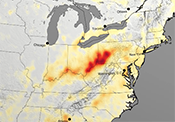Spatial Coverage is the Primary Advantage of NASA Satellite Data for Health and Air Quality Applications

SO2 data from the Aura Ozone Monitoring Instrument (OMI). Figure credit: NASA.
Relative to surface air quality monitoring networks, the primary advantage of observing air pollution from space is global spatial coverage. Scientific researchers have shown the potential of satellite data of air pollutants to be used for a number of applications, such as monitoring air pollution concentrations and trends over a wide spatial area and determining where additional pollution mitigation efforts are needed (Streets et al., 2013; Duncan et al., 2014).
Air Pollutants Observed from Space
A number of important air pollutants are observed from instruments on satellites as discussed in Duncan et al. (2014).

NO2 data from the Aura Ozone Monitoring Instrument (OMI). Figure credit: NASA.
Nitrogen Dioxide (NO2): NO2 is unhealthy to breathe and is primarily generated during fossil fuel combustion, so thermal power plants and automobiles are the dominant sources.
Ozone (O3) & Precursors: At Earth's surface, O3 is unhealthy to breathe and also negatively impacts plants, reducing crop yields.
Particulate Matter (PM) & Precursors: PM are tiny particles (e.g., smoke and dust) that cause numerous health issues when breathed in.

